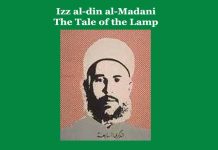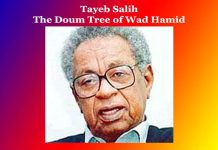Najib Mahfuz | Qismati and Nasibi | An Analytical Study
–Menonim Menonimus
Najib Mahfuz | Qismati and Nasibi | An Analytical Study
Najib Mahfuz | Qismati and Nasibi | An Analytical Study
‘Qismati and Nasib’ (Destiny and Fate) is a Greek-Arabic short story written by Najib Mahfuz (1911- 2006). As the title signifies, the short story deals with the theme of destiny. In addition to this, it also bears the theme of the contradiction of traits between two humans.
The theme of the story revolves around a couple: Mohsen Khalil and his wife Sitt Anabaya. Mohsen Khalil was a spice seller. He was a God-fearing man and lived in contentment with what he had. He had no dearth of property as there were chickens, geese, rabbits etc. But the couple had no children and it made them unhappy. They had tried everything to get children but to no avail. Sitt Anabaya had sought the advice of loved ones as well as fortune tellers, soothsayers and the like. She even visited shrines. Eventually, she went to see medical doctors. Unfortunately, their verdict was not encouraging in that the problems lay with both husband and wife. They added that there was hardly any hope left for them. So they were unhappy.
But as Mohsen approached his forty-fifth birthday and Sitt Anabaya turned forty, their prayers were finally answered and Sitt Anabaya, the wife of Mohsen got conceived. When she was certain that she was pregnant, she cried out, “Thank God and Siddi al-Khudri.”
After nine months Sitt Anabaya gave birth to a strange creature, the bottom half of which was indeed joined, with two legs and one abdomen, whereas the top half consisted of two parts each with its own chest, neck, head and face. The couple became astonished and bewildered and Mohsen said, “I wish it had never been born.”
At last, they resigned to their destiny and named the babies as Qismati and Nasibi. Qismati had a deep brown complexion with soft lineaments and hazel eyes while Nasibi had a white complexion with black eyes and a large nose.
As they began to grow up Qismati learned to speak more quickly but had to yield to Nasibi when it came to crawling and walking or playing with things. Nasibi seemed to remain dominant in their early years which were marked by naughtiness. The neighbours who saw them mocked at them. When they grew up to school-going age Mohsen brought them a tutor who instructed the boys in the basics of religion, language and Mathematics. Qismati’s learning was very encouraging but Nasibi had no desire to learn and was slower in his understanding. As a result, he resented his brother and disturbed him by singing, playing and childish teasing.
Qismati was calm and religious and eager to perform salat and fasting. But Nasibi did not. With the passing of time, the babies seemed to develop two contradictory traits of character. Qismati loved the cleanliness, while Nasibi hated the very idea of bathing unless he was obliged to do so. Qismati was fond of love songs while Nasibi loved loud music. The major source of disagreement, however, was caused by Qismati’s increasing love of reading and knowledge. As they had no playmates their mother provided two neighbouring children named Tariq and Samiha by persuading their mother. Tariq was a year older than the babies whereas Samiha was the same age. They began to develop a love for Samiha.
While they reached the age of reason and were on the verge of adolescence their problems reached a peak. Their suppressed dreams began to manifest themselves, threatening to explode. Each of them developed his own way of thinking and regarded the other as a threatening intruder. They were both fed up with the hateful unity that fate had inflicted upon them and from which there was no escape.
Subsequently, Nasibi became indomitable and developed evil intentions like stealing and seducing and one day he said boldly to his mother, “We need a wife. …. Since you gave birth to us, you’re responsible for getting us married to a nice girl.” The mother was astonished at the loss of words. Thus their characters were opposing to each other and each wished to get rid of the other at any cost.
They seemed like two friends without a friendship, in an alliance without sincerity. However, age prematurely left its traces on Nasibi’s face, revealing that he was rapidly approaching old age. At last one day, Nasibi died while Qismati survived. After the doctor’s suggestion, his dead body was mummified. Since the death of Nasibi, Qismati’s began to feel half dead. He lost all interest in life.
Thus the author Najib Mahfuz brings about the theme of destiny and the sufferance of a couple through the short story.
There are four characters in the story-Mohsen, his wife Sitt Anabaya, and their sons Qismati and Nasibi. But among these four characters, our attention goes to Qismati and Nasibi. Through them, the author shows that character and personality differ from person to person.
As for the structure of the story, it is something loose. In the exposition, we see that Mohsen and his wife Sitt Anabaya are unhappy because they are devoid of offspring. In the rising action, we see that Sitti Anabaya has gotten pregnant. When Sitty Anabaya gives birth to a child the bottom half of which was indeed joined with two legs and an abdomen, whereas the top half consisted of two parts: each with its own chest, neck, head and face, then the story reaches its climax. In the falling action, the author has depicted the contradictory characters of the two brothers. The story meets its denouement with the death of Nasibi.
The dialogues used in the story are sparing and reliable which have contributed to the development of the story and succeeded in revealing the inner feelings, emotions and motives of the characters. Here is to say that Najib Mahfuz is a master of creating dialogue. The following citation is enough to substantiate it.
Mohsen sighed and said, “We will become a laughing stock and the talk of the town!”
“Patience is a virtue!”
“But would not it better to consider the child as two, with a single abdomen?”
“He can’t deal with life except as a single person.”
They stood in silence exchanging glances until she asked him:
“What do you want to call him?”
As he kept silent, she said, “Muhammadayn! Do you think this is a suitable name?”
He did not utter a word, shaking his head in resignation.
The Setting of the story is weak. The author neglects to portray the manners, customs, costumes, atmosphere etc. of the characters and situation in the story.
Through the story, the author wants to convey his philosophy that, ”God creates people the way He sees fit.”
The Language of the story is simple and easy to comprehend though he has used some verses as solace in distress from the Bible.
In maintaining the Qualities of a good short story as —unity of purpose, brevity, spontaneity and universality the author has succeeded somehow.
To conclude it may be said that the story ‘Qismati and Nasibi’ by Najib Mahfuz is a fine and enjoyable short story on the theme of destiny and inborn human traits. 0 0 0
Najib Mahfuz | Qismati and Nasibi | An Analytical Study
Read More: Izz al-din al-Madani Short Story ‘The Tale of the Lamp’-An Analytical Study
Najib Mahfuz | Qismati and Nasibi | An Analytical Study
N. B. This article entitled ‘Najib Mahfuz | Qismati and Nasibi | An Analytical Study’ originally belongs to the book ‘Analytical Studies of Some Arabic Short Stories‘ by Menonim Menonimus. Najib Mahfuz | Qismati and Nasibi | An Analytical Study
Books of Literary Criticism by M. Menonimus:
- World Short Story Criticism
- World Poetry Criticism
- World Drama Criticism
- World Novel Criticism
- World Essay Criticism
- Indian English Poetry Criticism
- Indian English Poets and Poetry Chief Features
- Emily Dickinson’s Poetry-A Thematic Study
- Walt Whitman’s Poetry-A Thematic Study
- Critical Essays on English Poetry
- Tawfiq al-Hakim’s Novel: Return of the Spirit-An Analytical Study
- Tawfiq al-Hakim’s Novel: ‘Yawmiyyat Naib Fil Arayaf’-An Analytical Study
- Analytical Studies of Some Arabic Short Stories
- A Brief History of Arabic Literature: Pre-Islamic Period …
Related Searches:
- Qismati and Nasibi
- Najib Mahfuz
- Excerpt from the Egyptian Book of the Dead
- Book of the Dead Summary
- Muhammad al-Zafzaf
- A Literary Analysis Sacred Tree’
- A Handful of Dates Summary
- A Handful of Dates by Tayeb Salih
- Notes on ‘The Doum Tree of Wad Hamid’
- The Image of Woman in the Writings of Zakariyya Tamer
- A Lonely Woman
- Tale of the Lamp
- Izz al-din al-Madani
- Arabic Short Stories Archives
- Modern Arabic Literature











